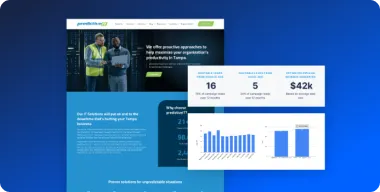Online industrial marketing is unique in many ways. Whereas service pages are good enough for a website in almost any other industry, simply telling your customers that you offer machining services is not the same as providing thorough details of what materials or machines you offer.
To help focus your efforts and ensure you have everything you need before launching an industrial marketing campaign, here are several factors to keep in mind. This cheat sheet will help ensure you’re ready to hit the go button when you’re preparing new marketing materials.
Persona Targeting
Every good marketing campaign should target people who are most likely to benefit from it. In the industrial arena, that means procurement managers, engineers, and even the men and women on the floor installing parts and making upgrades.
Every aspect of your marketing campaign should take these into consideration:
- Persona Identification – Do you know who your target personas are? Does the content you produce reflect the needs of those people?
- Engineering – Is your engineering content focused on form, fit and function, with specific facts and figures to back up your claims? Is it short and consumable while still providing real value?
- Procurement – Is your procurement content focused primarily on certification adherence and cost? Do you make it clear what your capabilities are and how they are compared to your competitors?
- Management – Do you address the major questions someone in management would ask about working with a company like yours?
Resources – There are several things every good manufacturing website should have:
- Photos of products and services
- Certifications for download
- Catalogs and documentation
- Industry-specific content
- Case studies of past work
- Product details
- Contact information
Content Marketing 101
Do you have a basic content marketing plan in place? A content marketing plan dictates how your content is created, what it’s about, and what purpose it will serve.
Remember: everything you create should serve a very specific purpose, rather than exist to fill space on the calendar. Here are certain things you should consider:
Editorial Policy – Do you have standards in place for your blog and website content. Ask yourself these questions:
- Do you write news topics?
- How many pieces are dedicated to company topics?
- How well can your writers tell stories about your projects?
- Do you interview employees to gather quotes and necessary information?
- Who approves content and what factors do they consider?
- What is off limits for your content?
- Topic Focus – What specific topics will you cover and how will you approach them? Are you publishing solely about your products and their industry needs, or will you discuss manufacturing topics as a whole?
- Do you have the About content? – Are your authors featured on the blog so readers will know who they are and what their expertise is?
- What is your commenting policy? – How do you handle comments from users? This applies to both your site and social media. Do you approve all comments or curate them?
- Have a plan for Tracking KPIs – What are your KPIs and how will you track them for each piece of content?
- Create and Manage a Schedule – Build an editorial calendar and make sure you have the due diligence to follow it. If you plan to publish your content weekly, you need to know what content will be published and by whom. Build a plan for topics in advance.
- Establish Backup Plans – Who will write content if someone is out of the office? Do you have a freelancer or agency on tap who can support your efforts if your team gets too busy?
Formatting and Editorial
For online marketing, much of what you do will be published and read or watched. So it needs to be of the highest quality to best represent your company. Consider the following:
Headlines – Are your headlines catchy, interesting, and specific to the problems your audience has?
Readability – Is your content presented in an easy-to-read format? That means:
- Paragraphs are limited to 3-6 lines each
- 2-3 subheadlines for every 500 words of text
- Bullet points to break up key ideas and improve readability
- Use of images to break up the text and create white space
- Call To Action – Does every piece of content you produce have a clear call to action like “contact us” or “get a free quote” that guides readers to the next step in the process?
- Proofreading – What is your proofreading process? How is every piece of content vetted before publication? Make sure you have people in place to check for grammar, spelling, and formatting.
- Image Use – Aim to include one image for every 350 words of text. This applies to all your written material, including your website’s pages, blog content, and eBooks.
SEO and Technical Considerations
In the online world, content production and marketing efforts have two goals – to help your readers solve a problem and to improve your ranking in search engines, thus driving new traffic to your website. For the latter, consider the following:
- Keywords – Every page and blog post should have a single primary keyword associated with it. Know in advance what that term will be and ensure it is used 3-5 times throughout the text.
- URLs – Keep your URLs short and readable. Aim for around five words to ensure they aren’t too long. Make sure your keyword is included in the text.
- Images – Make sure your images have the right file names with keywords included, and that they have ALT tags applied with keyword information in them.
- Title and META Tags – Every page should have unique title tags and META description to ensure they are easy to find and enticing to click in search engine results.
- Length – The minimum number of words on any given page of your site should be 350. Longer is always better.
Promoting Your Content
Going to the trouble of creating a ton of fascinating content means nothing if you don’t have a plan for promoting it when it’s published. Keep the following in mind:
- Social Media – Manage relevant social media accounts. For industrial buyers, LinkedIn is a must, Twitter can be effective, and other social networks should be used only if you have ample time to manage them. Publish all new content to your social channels and connect them to your blog.
- LinkedIn Groups – Choose 5-7 LinkedIn groups related to your audience and remain active in each, posting interesting content there on a regular basis. These groups can be powerful sources of both traffic and new leads.
- Republish Content – Choose 2-3 channels and republish content in new formats. SlideShare is great for many technical topics. Reddit and other social bookmarking sites can also be very effective if used on a recurring basis to build an audience.
- Email – Send content to your existing prospects and customers to encourage sharing, and keep them active in your marketing funnel.
- Make Finding Content Easy – Setup an RSS feed for your blog, offer subscription options for your content on the site, and share content via your email signature to make it easy to find.
- Competitors – Review what your competitors are doing to promote their own content and borrow ideas that seem to be working best. This is especially true for advertising.
- Contact Experts – Reach out to leaders in your industry and share your content with them. Comment on their content as well and build a relationship with people who can help you reach a wider audience.
- Engage Staff – Get your employees involved. Ask them to submit and promote content. Have them share it with their contacts and encourage responsible social media use.
- Total Visits – How many people visit your website as a direct result of your marketing efforts?
- Location – Where are the people who visit your website from? Are they within the geographic regions you are targeting?
- Mobile vs. Desktop – What percentage of your visitors are using mobile devices? On average, 15-20% of industrial website visitors do so from a tablet or phone.
- Bounce Rate – The bounce rate is the percentage of people who leave immediately upon entering a site. Aim for a number below 60%.
- Time on Site – How long do your prospects spend on your website?
- Clicks and Attention – Using Google Analytics or a third party tool like Crazy Egg, allows you to see where people click on your website, what captures their attention, and what they are ignoring.
- Total Page Views – How many pages is each visitor actually looking at? And which ones are they viewing more often than others?
- Comments and Engagement – How many comments, likes, shares, and reposts are you getting for the content you produce on social media and on your blog?
- Conversion Rates – What percentage of visitors convert from a prospect to a lead by completing a form?
Customer Conversion Rate – What percentage of your new web-based leads turn into customers within the timeframe of your average sales cycle?
Tracking Results for Your Marketing Campaigns
Last but not least, you need to track the results of your efforts. A good content marketing strategy can be cost-effective and bring you desired results, but if you’re not tracking your KPIs carefully, you’ll never know what works and what doesn’t. Some things to keep in mind:
By measuring these items and knowing where your site visitors come from, what time they pay a visit to your site, and how many are converted into leads (and ultimately customers), you can evaluate and track your efforts from top to bottom in any of your marketing campaigns.






